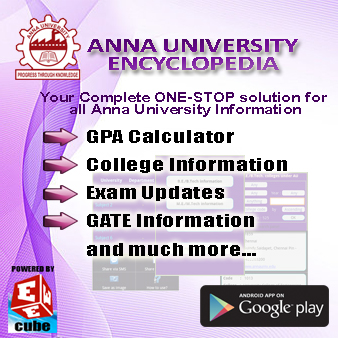SUBJECT RESOURCES:
CLICK HERE to access 'Question Banks'
CLICK HERE to access 'Previous Year Question Papers'
CLICK HERE to search more about this subject
SYLLABUS:
• Conventional and non-conventional energy
sources
and energy
storage
devices and Chemistry of engineering materials
Characteristics – alkalinity – types of alkalinity and determination – hardness – types and estimation by EDTA method (problems); Domestic water treatment – disinfection methods (Chlorination, ozonation. UV treatment) – Boiler feed water – requirements
Adsorption – types – adsorption of gases on solids – adsorption isotherms – Frendlich and Langmuir isotherms – adsorption of solutes from solution – role of adsorbents in catalysis, ion-exchange adsorption and pollution abatement.
2. B. Sivasankar
“Engineering Chemistry”
Tata McGraw-Hill
Pub.Co.Ltd,
New
Delhi (2008).
CLICK HERE to access 'Question Banks'
CLICK HERE to access 'Previous Year Question Papers'
CLICK HERE to search more about this subject
SYLLABUS:
CY2111 ENGINEERING CHEMISTRY
– I 3 0 0 3
AIM
To impart
a sound knowledge
on the principles of chemistry involving the different application oriented topics required for all engineering branches.
OBJECTIVES
• The student
should
be conversant
with the principles water characterization and treatment of potable and industrial purposes.
• Principles of polymer chemistry and engineering applications of polymers
• Industrial applications of surface chemistry
|
UNIT I WATER TECHNOLOGY 9
Characteristics – alkalinity – types of alkalinity and determination – hardness – types and estimation by EDTA method (problems); Domestic water treatment – disinfection methods (Chlorination, ozonation. UV treatment) – Boiler feed water – requirements
– disadvantages
of using hard water
in boilers – internal conditioning
(phosphate,
calgon and carbonate conditioning methods) – external conditioning
–
demineralization process – desalination and reverse osmosis.
UNIT II POLYMERS AND COMPOSITES 9
Polymers-definition – polymerization – types – addition
and condensation polymerization
– free radical polymerization mechanism – Plastics, classification – preparation, properties and uses of PVC, Teflon, polycarbonate, polyurethane, nylon-
6,6, PET- Rubber -vulcanization
of rubber, synthetic rubbers
– buty1 rubber, SBR, Composites – definition, types polymer matrix composites
– FRP only.
UNIT III SURFACE CHEMISTRY 9
Adsorption – types – adsorption of gases on solids – adsorption isotherms – Frendlich and Langmuir isotherms – adsorption of solutes from solution – role of adsorbents in catalysis, ion-exchange adsorption and pollution abatement.
UNIT IV NON-CONVENTIONAL ENERGY SOURCES
AND STORAGE DEVICES 9
Nuclear energy
– fission and fusion
reactions
and light
water nuclear reactor for power
generation (block diagram
only) – breeder reactor – solar energy conversion – solar cells
– wind energy – fuel cells
– hydrogen – oxygen
fuel cell – batteries
– alkaline
batteries – lead–acid, nickel–cadmium and lithium batteries.
UNIT V ENGINEERING MATERIALS
9
Refractories – classification – acidic, basic and neutral refractories – properties (refractoriness, refractoriness under load,
dimensional stability, porosity, thermal spalling) –
manufacture of alumina,
magnesite
and
zirconia
bricks,
Abrasives – natural and synthetic abrasives –
quartz, corundum, emery, garnet, diamond,
silicon
carbide and boron carbide. Lubricants – mechanism of lubrication, liquid lubricants, - properties – viscosity index,
flash and fire points,
cloud and pour points, oilyness)
– solid lubricants – graphite
and molybdenum sulphide.
Nanomaterials
– introduction to nanochemistry
– carbon nanotubes and their applications
TOTAL: 45 PERIODS
TEXT BOOKS:
1. P.C.Jain and Monica Jain, “Engineering Chemistry” Dhanpat Rai Pub, Co., New Delhi (2002).
2.
S.S.
Dara “A text book of engineering chemistry” S.Chand
& Co.Ltd., New
Delhi
(2006).
REFERENCES:
1. B.K.Sharma “Engineering chemistry” Krishna Prakasan Media (P) Ltd.,
Meerut (2001).
|
Delhi (2008).
|
|










No comments:
Post a Comment
Note: Only a member of this blog may post a comment.